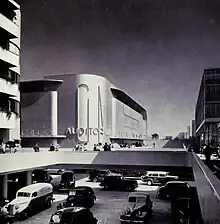Norman Bel Geddes
Norman Bel Geddes (born Norman Melancton Geddes; April 27, 1893 – May 8, 1958) was an American theatrical and industrial designer.[1]
Norman Bel Geddes | |
|---|---|
 | |
| Born | Norman Melancton Geddes April 27, 1893 Adrian, Michigan, U.S. |
| Died | May 8, 1958 (aged 65) New York, New York, U.S. |
| Nationality | American |
| Occupation(s) | Theatrical designer Industrial designer |
| Notable work | Airliner Number 4 Futurama Mark I computer case |
| Spouses |
|
| Children | Barbara Bel Geddes Joan Bel Geddes Ulanov |

Early life
Bel Geddes was born Norman Melancton Geddes in Adrian, Michigan and was raised in New Philadelphia, Ohio, the son of Flora Luelle (née Yingling) and Clifton Terry Geddes, a stockbroker.[2] When he married Helen Belle Schneider in 1916, they combined their names to Bel Geddes.[3] Their daughters were actress Barbara Bel Geddes[4] and writer Joan Ulanov.[5]
Career

Bel Geddes began his career with set designs for Aline Barnsdall's Los Angeles Little Theater in the 1916–17 season, then in 1918 as the scene designer for the Metropolitan Opera in New York. He designed and directed various theatrical works,[6] from Arabesque and The Five O'Clock Girl on Broadway to an ice show, It Happened on Ice, produced by Sonja Henie. He also created set designs for the film Feet of Clay (1924), directed by Cecil B. DeMille, designed costumes for Max Reinhardt, and created the sets for the Broadway production of Sidney Kingsley's Dead End (1935).
Bel Geddes opened an industrial-design studio in 1927, and designed a wide range of commercial products, from cocktail shakers to commemorative medallions to radio cabinets. His designs extended to unrealized futuristic concepts: a teardrop-shaped automobile, and an Art Deco House of Tomorrow.[7] In 1929, he designed "Airliner Number 4," a 9-deck amphibian airliner that incorporated areas for deck-games, an orchestra, a gymnasium, a solarium, and two airplane hangars.[8]
His book Horizons (1932) had a significant impact: "By popularizing streamlining when only a few engineers were considering its functional use, he made possible the design style of the thirties."[9] He wrote forward-looking articles for popular American periodicals.[10][11]
In the classic science fiction film of H. G. Wells' Things to Come (1936), he assisted production designer William Cameron Menzies on the look of the world of tomorrow.
Bel Geddes designed the General Motors Pavilion, known as Futurama, for the 1939 New York World's Fair. For that famous and enormously influential installation, Bel Geddes exploited his earlier work in the same vein: he had designed a "Metropolis City of 1960" in 1936.[12]
Bel Geddes's book Magic Motorways (1940) promoted advances in highway design and transportation, foreshadowing the Interstate Highway System, along with aspects of driver assist and autonomous driving.[13]
The case for the Mark I computer was designed by Bel Geddes at IBM's expense, and put in place just in time for the machine's dedication at Harvard University.[14]
Death and legacy
Bel Geddes died in New York on May 8, 1958.[3] His autobiography, Miracle in the Evening, was published posthumously in 1960.
Bel Geddes is a member of the American Theater Hall of Fame, a distinction he shares with his daughter, actress Barbara Bel Geddes.[15] The United States Postal Service issued a postage stamp honoring Bel Geddes as a "Pioneer Of American Industrial Design".[16]
The archive of Norman Bel Geddes is held by the Harry Ransom Center at the University of Texas at Austin. This large collection includes models, drafts, watercolor designs, research notes, project proposals, and correspondence. The Ransom Center also holds the papers of Bel Geddes' second wife, the noted costume designer and producer Edith Lutyens Bel Geddes.[17]
Gallery
 Model of teardrop-shaped automobile designed by Bel Geddes
Model of teardrop-shaped automobile designed by Bel Geddes General Motors 25th anniversary medal, 1933, featuring teardrop shaped car
General Motors 25th anniversary medal, 1933, featuring teardrop shaped car "Through the City of Tomorrow Without a Stop", Shell Oil advertisement, 1937.
"Through the City of Tomorrow Without a Stop", Shell Oil advertisement, 1937. Norman Bel Geddes. Cocktail Set. 1937. Brooklyn Museum
Norman Bel Geddes. Cocktail Set. 1937. Brooklyn Museum A full scale street intersection in the City of the Future at the Futurama exhibit at the 1939 New York World's Fair
A full scale street intersection in the City of the Future at the Futurama exhibit at the 1939 New York World's Fair.jpg.webp)
Selected publications
- Horizons Little Brown, Boston, 1932.
- "Streamlining", Atlantic Monthly, No. 154 (November 1934), pp. 553–558.
- Magic Motorways. Random House, New York, 1940.
- Miracle in the Evening: An Autobiography. Doubleday, New York, 1960. Edited by William Kelley.
See also
References and notes
- Dyal, Donald H. (1983). Norman Bel Geddes: Designer of the Future. Monticello, IL: Vance Bibliographies. ISBN 9780880665841.
- Pylant, James (2005). "The Midwestern Roots of Barbara Bel Geddes ("Miss Ellie")". GenealogyMagazine.com. Datatrace Systems. Archived from the original on August 27, 2012. Retrieved October 21, 2012.
- Magill, Frank N. (2013). The 20th Century A-GI: Dictionary of World Biography, Volume 7. Routledge. p. 1319. ISBN 978-1136593345.
- Fox, Margalit (2005-08-11). "Barbara Bel Geddes, Lauded Actress, Dies at 82". The New York Times.
- Ratliff, Ben (May 7, 2000). "Barry Ulanov, 82, a Scholar Of Jazz, Art and Catholicism". The New York Times.
- Works, Bernhard Russell (1966). Norman Bel Geddes: Man of Ideas (Thesis). Madison, WI: University of Wisconsin Press. OCLC 3116381.
- Tinniswood, Adrian (2002). The Art Deco House. New York: Watson-Guptill. p. 20. ISBN 9780823003150.
- Stephens, Ian (March 29, 2009). "Huge Aviation of the 1930s: The K-7 and The Bel Geddes #4". Fly Away Simulation. Retrieved October 21, 2012.
- Meikle, Jeffrey L. (2001). Twentieth Century Limited: Industrial Design in America, 1925–1939 (2nd ed.). Philadelphia: Temple University Press. p. 48. ISBN 9781566398923.
- Bel Geddes, Norman (November 1934). "Streamlining". Atlantic Monthly: 553–558.
- Bel Geddes, Norman (January 1931). "Ten Years From Now". The Ladies' Home Journal: 190.
- Wolf, Peter M. (1974). The Future of the City: New Directions in Urban Planning. New York: Watson-Guptill. p. 28. ISBN 9780823071821.
- Magic motorways by Norman Bel Geddes, 1940, pp. 43-56. Quote: "But these cars of 1960 and the highways on which they drive will have in them devices which will correct the faults of human beings as drivers. They will prevent the driver from committing errors. They will make it possible for him to proceed at full speed through dense fog."
- pp.7-8
- "Theater Hall of Fame members".
- Hopper, Grace Murray (January 7, 1969). "Computer Oral History Collection, 1969-1973, 1977" (PDF) (Interview). Interviewed by Uta C. Merzbach. Washington, D.C.: Archives Center, National Museum of American History. Archived from the original (PDF) on February 23, 2012. Retrieved October 21, 2012.
- "Norman Bel Geddes Database". norman.hrc.utexas.edu. Retrieved 2022-01-14.
External links
- Norman Bel Geddes Archive at the Harry Ransom Center, University of Texas at Austin
- To New Horizons, film about Geddes' display at the 1939/40 World's Fair